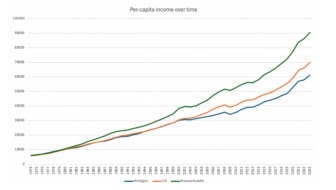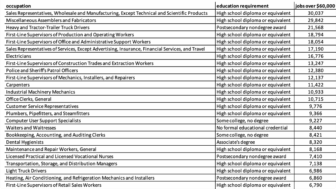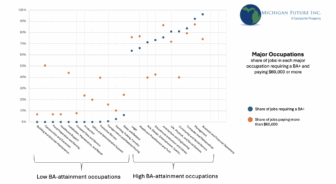If you’ve been following this blog, you know we recently released the second in-depth topic paper outlining the ![]() proposed policy changes that we believe can help put Michigan back on a path to prosperity. To us, a prosperous state is one in which almost every adult is working, and where that work pays a good wage. Along with two other levers–– dramatically improving the education system to prepare our kids for the 21st century economy and creating cities where people want to live—we believe that it’s important to take several steps to support those who are struggling in our new economy. The first two areas of recommended policy change were summarized in Pat’s two posts, “A safety net that promotes opportunity” and “Increasing wages and supports for Michigan workers”. Today, I’ll be sharing an overview on criminal justice reform.
proposed policy changes that we believe can help put Michigan back on a path to prosperity. To us, a prosperous state is one in which almost every adult is working, and where that work pays a good wage. Along with two other levers–– dramatically improving the education system to prepare our kids for the 21st century economy and creating cities where people want to live—we believe that it’s important to take several steps to support those who are struggling in our new economy. The first two areas of recommended policy change were summarized in Pat’s two posts, “A safety net that promotes opportunity” and “Increasing wages and supports for Michigan workers”. Today, I’ll be sharing an overview on criminal justice reform.
As I wrote in an earlier post:
There is no way Michigan can enter an era of broad prosperity when it is incarcerating 770 out of every 100,000 residents, and spending 20 percent of its general fund budget on corrections. The costs to the state swell far beyond the actual cost of incarceration, when you factor in the experience of those who are re-entering society from prison. They face incredible difficulty finding employment, prohibitions on qualifying for welfare, housing discrimination, and issues with substance abuse, among other challenges. This swirl of challenges certainly plays a role in Michigan’s recidivism rate, which has hovered around 30 percent for the past decade.
Criminal justice reform is a relatively new area of concern for Michigan Future as an organization, and at first might appear far afield from the rest of our recommendations. But the truth is that our criminal justice system is systematically locking people out of the economy in ways that go well beyond delivering “justice.” Keeping them locked out has repercussions for all the rest of us. It is clear that the current prison system is having impacts far beyond those inherent to its intent.
With that understanding, and the belief that our policy goals must be centered around more adults working, we explored criminal justice reforms from around the country that balance appropriate punishment of criminal activity with an attempt to limit the additional, far-reaching repercussions. Ultimately, we need to offer a path to legitimate, family-supporting work to people who have paid their time. Most of these reforms also provide cost savings to the state and have been shown to reduce recidivism. In other words, they increase safety and stability for rest of Michigan’s citizens. We consider the worthwhile goals to be:
Keeping people out of the justice system entirely when appropriate, and especially when an alternative response can help address underlying behavior.
Sentencing reform—eliminating and reducing mandatory minimums or providing greater flexibility to judges—can reduce artificially inflated sentences for nonviolent criminals that became widespread during the “tough on crime” era. Specialty courts are thought to provide a more holistic approach to criminal activity that is related to, for instance, drug addiction, though experts are divided about the efficacy of these courts at reducing recidivism.
I became very interested in arrest diversion programs such as the LEAD program being piloted in Seattle (which I wrote about here), because of the ways they are empowering to police officers who would like additional tools for responding to mental illness and drug-related offenses. It’s hard to know how a stay in prison makes it more likely for the mentally ill and drug addicted to avoid further criminal activity.
For young people, I would argue there is an even stronger ethical imperative to provide alternatives to incarceration and to provide support. The Wayne County Juvenile Assessment Center is actually considered a national model in providing case management that allows adjudicated youth to be comprehensively assessed and supported with counseling, drug treatment, and other care. I was also really interested to learn about an arrest diversion program in Florida that helps young people completely avoid arrest if, after assessment, they commit to a set of interventions.
Ensuring that we aren’t unnecessarily inflating prison sentences, or returning people to prison on technicalities, through probation and parole reforms.
Several states have instituted “presumptive parole” programs, which reduces the onus on the nonviolent incarcerated individual to prove readiness for parole; instead parole is presumed once a portion of the minimum sentence is completed (absent other factors). “Swift, certain, fair” probation measures are a response to the fact that too often, the repercussions of parole violations were either not commensurate to the violation, or were administered too long after the violation, reducing their ability to drive behavior. Instead, swift, certain, fair probation levies immediate but moderate responses to parole violations and helps keep people from returning to prison.
Reducing and removing the barriers to education, support, and employment that severely hamper the ability of returning citizens to participate in their communities and the economy.
I was surprised to learn about the many restrictions that states impose against ex-felons from receiving state support, such as food stamps and cash assistance. When people leave prison, they usually reenter the community that they left. They face a difficult time gaining employment, housing discrimination, struggle with poorly designed education and worker training programs, and on top of that, can be excluded from social safety net supports. We have to find ways to reduce these barriers that make productive reentry a pipe dream.
In each of these areas we researched and present ideas and policies that are currently at work in other places. However, this isn’t an area where one policy suggestion clearly rises above the rest. While there are a range of responses to consider, we suggest that we need to be clear about the goals: finding alternatives to incarceration when appropriate, reducing sentences for nonviolent offenses when incarceration is unavoidable, and reducing barriers to successful community reentry.
To read the full report, A Path to Good-paying Careers for all Michiganders: Sharing prosperity with those not participating in the high-wage knowledge-based economy, click here.







